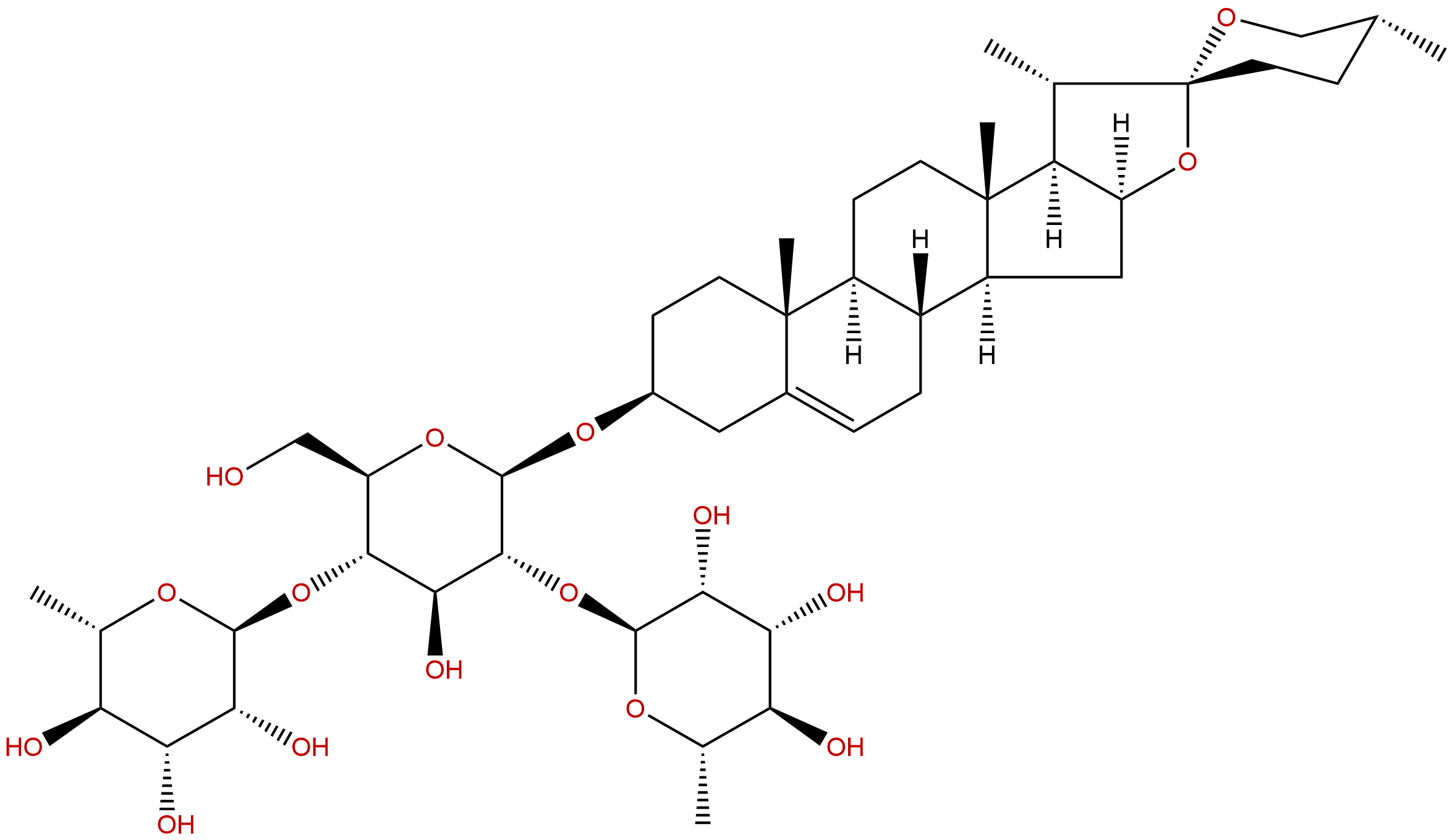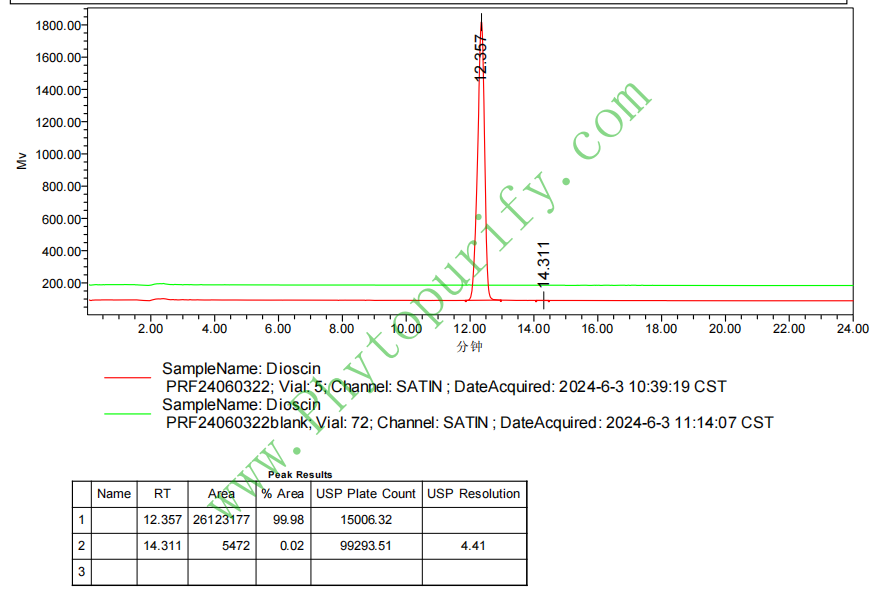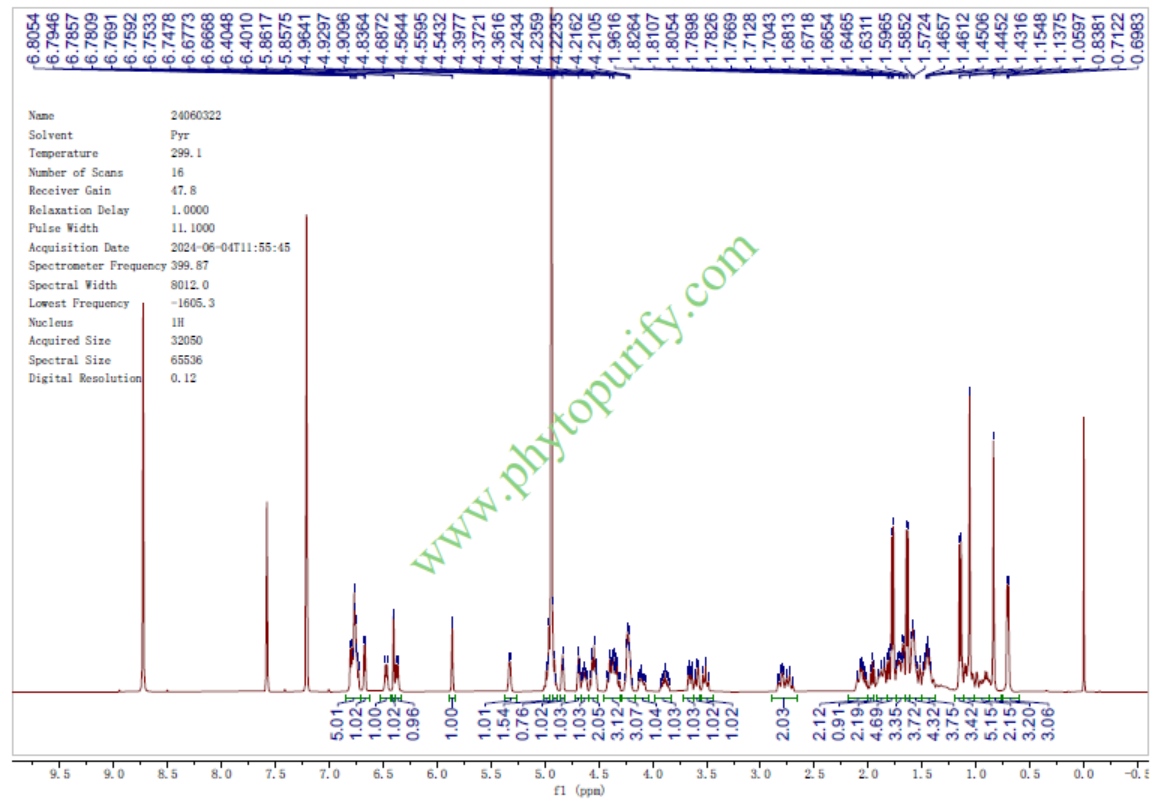
DioscinCAS No.:19057-60-4
|
||||||||||
 |
|
|
||||||||

| Catalogue No.: | BP0503 |
| Formula: | C45H72O16 |
| Mol Weight: | 869.055 |
Product name: Dioscin
Synonym name: Collettinside III
Catalogue No.: BP0503
Cas No.: 19057-60-4
Formula: C45H72O16
Mol Weight: 869.055
Botanical Source: Allium ampeloprasum (leek), Brachiaria decumbens, Dioscorea colletti var. hypoglauca, Dioscorea tokora, Paris dunniana, Paris tetraphylla, Trillium grandiflorum and Trillium tschonoskii
Physical Description: Powder
Type of Compound: Steroids
Purity: 95%~99%
Analysis Method: HPLC-DAD or/and HPLC-ELSD
Identification Method: Mass, NMR
Packing: Brown vial or HDPE plastic bottle
Storage: Store in a well closed container, protected from air and light. Put into refrigerate or freeze for long term storage.
Whenever possible, you should prepare and use solutions on the same day. However, if you need to make up stock solutions in advance, we recommend that you store the solution as aliquots in tightly sealed vials at -20℃. Generally, these will be useable for up to two weeks.
The product could be supplied from milligrams to grams, up to kilograms
Inquire for bulk scale.
Descriptions:
Dioscin, a saponin extracted from the root of Polygonatum Zanlanscianense Pamp, can markedly inhibit proliferation of Hela cells, underwent apoptosis in dose- and time-dependent manner.[1]
Dioscin shows remarkable protective effect against acetaminophen-induced liver damage in vitro and in vivo by adjusting mitochondrial function.[2]
Dioscin induces generation of reactive oxygen species through mitochondria dysfunction, is capable of inducing apoptosis in mammalian cells, in which the mitochondria-initiated apoptosis pathway plays an important role.[3]
Dioscin can restore the activity of the anticancer agent adriamycin in multidrug-resistant human leukemia K562/adriamycin cells by down-regulating MDR1 via a mechanism involving NF-κB signaling inhibition.[4]
Dioscin shows little inhibition activity of tyrosinase, whereas oxyresveratrol, a known tyrosinase inhibitor, shows a strong tyrosinase inhibitory activity , and a mixture of oxyresveratrol and dioscin (IC50 = 5.1 and 5.7 μg/ml) highly increases the inhibition of tyrosinase activity with l-tyrosine or l-DOPA as the substrate as compared to either oxyresveratrol (IC50 = 7.8 and 10.9 μg/ml) or dioscin (IC50 > 100 and 100 μg/ml) alone.[5]
Dioscin has been shown to promote anticancer activity against several forms of cancers, it induces apoptosis in cancer cells through the induction of oxidative stress, peroxiredoxins 1and 6 (PRDX 1 and 6) are key targets in the process of dioscin-induced apoptosis that involves intracellular elevated ROS.[6]
Rhizoma Dioscoreae septemlobae (RDSE) and its main component dioscin (DIS) display a weak xanthine oxidase (XO) inhibition activity compared with allopurinol, therefore, they processed uricosuric and nephroprotective actions by regulation of mOAT1, mURAT1 and mOCT2.[7]
References:
[1] Cai J, Liu M, Wang Z, et al. Biol Pharml Bull, 2002, 25(2):193-6.
[2] Zhao X, Cong X, Zheng L, et al. Toxicol Lett, 2012, 214(1):69-80.
[3] Wang Y, Che C M, Chiu J F, et al. J Proteome Res, 2007, 6(12):4703-10.
[4] Wang L, Meng Q, Wang C, et al. J Nat Prod, 2013, 76(5):909-14.
[5] Liang C, Lim J H, Kim S H, et al. Food Chem, 2012, 134(2):1146-8.
[6] Wang Z, Cheng Y, Wang N, et al. Cancer Biol Ther, 2012, 13(3):138-47.
[7] Su J, Wei Y, Liu M, et al. Arch Pharm Res, 2014, 37(10):1336-44.
[8] Dong-Xiang L I, Qing L I, Guan X Y, et al. Chinese J Pharm Anal, 2012, 32(4):596-8.
HPLC of Dioscin

HNMR of Dioscin
